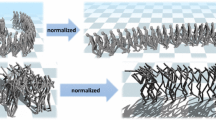Abstract
In this study we treat scribbling motion as a compositional system in which a limited set of elementary strokes are capable of concatenating amongst themselves in an endless number of combinations, thus producing an unlimited repertoire of complex constructs. We broke the continuous scribblings into small units and then calculated the Markovian transition matrix between the trajectory clusters. The Markov states are grouped in a way that minimizes the loss of mutual information between adjacent strokes. The grouping algorithm is based on a novel markov-state bi-clustering algorithm derived from the Information-Bottleneck principle. This approach hierarchically decomposes scribblings into increasingly finer elements. We illustrate the usefulness of this approach by applying it to human scribbling.







Similar content being viewed by others
References
Berthier, N. E. (1996). Learning to reach: A mathematical model. Developmental Psychology, 32, 811–823.
Bizzi, E., Tresch, M. C., Saltiel, P., & dAvella, A. (2000). New perspectives on spinal motor systems. Nature Reviews. Neuroscience, 1, 101–108.
Dempster, A., Laird, N., & Rubin, D. (1977). Maximum likelihood estimation from incomplete data via the em algorithm. Journal of the Royal Statistical Society. Series B, 39, 1–38.
Dhillon, I. S., Mallela, S., & Modha, D. S. (2003). Information-theoretic co-clustering. In International conference on knowledge discovery and data mining (KDD).
Flash, T., & Henis, E. A. (1991). Arm trajectory modification during reaching towards visual targets. Journal of Cognitive Neuroscience, 3, 220–230.
Flash, T., & Hochner, B. (2005). Primitives in vertebrates and invertebrates. Current Opinion in Neurobiology, 15, 660–666.
Flash, T., & Hogan, N. (1985). Coordination of arm movements: An experimentally confirmed mathematical model. Journal of Neuroscience, 5, 1688–1703.
Ge, X., Parise, S., & Smyth, P. (2003). Clustering Markov states into equivalence classes using svd and heuristic search algorithms. AISTATS.
Georgopolulos, A. P., Kalaska, J. F., Caminiti, R., & Massey, J. T. (1982). On the relations between the direction of two-dimensional arm movements and cell discharge in primate motor cortex. Journal of Neuroscience, 2, 1527–1537.
Giszter, S., Bizzi, E., & Mussa-Ivaldi, F. A. (1991). Computations underlying the execution of movement: A novel biological perspective. Science, 253, 287–291.
Hofsten, C. (1991). Structuring of early reaching movements: A longitudinal study. Journal of Motor Behavior, 23, 280–292.
Konczak, J., Borutta, M., Topka, H., & Dichgans, J. (1995). The development of goal-directed reaching in infants: Hand trajectory formation and joint force control. Experimental Brain Research, 106, 156–168.
Krebs, H. I., Aisen, M. L., Volpe, B. T., & Hogan, N. (1999). Quantization of continuous arm movements in humans with brain injury. Proceedings of the National Academy of Sciences, 96, 4645–4649.
Lacquaniti, F., Terzuolo, C., & Viviani, P. (1983). The law relating kinematic and figural aspects of drawing movements. ACTA Psychologica, 54, 115–130.
Mataric, M. J. (2001). Sensory-motor primitives as a basis for imitation: Linking perception to action and biology to robotics. In Imitation in animals and artifacts. Cambridge: MIT.
Meila, M., & Shi, J. (2001). A random walks view of spectral segmentation. AISTATS.
Mussa-Ivaldi, F. A., & Bizzi, E. (2000). Motor learning through the combination of primitives. Philosophical Transactions of the Royal Society of London. Series B, Biological Sciences, 355, 1755–1769.
Slonim, N., & Weiss, Y. (2003). Maximum likelihood and the information bottleneck. Proceedings of neural information processing systems.
Slonim, N., Friedman, N., & Tishby, N. (2002). Unsupervised document classification using sequential information maximization. ACM SIGIR, 129–136.
Slonim, N., Friedman, N., & Tishby, N. (2006). Multivariate information bottleneck. Neural Computation, 18, 1739–1789.
Sosnik, R., Shemesh, M., & Abeles, M. (2007). The point of no return in planar hand movements: An indication of the existence of high level motion primitives. Cognitive Neurodynamics, 1, 341–358.
Stark, E., Drori, R., Asher, I., Ben-Shaul, Y., & Abeles, M. (2007). Distinct movement parameters are represented by different neurons in the motor cortex. European Journal of Neuroscience, 26, 1055–1066.
Tappert, C. C. (1982). Cursive script recognition by elastic matching. IBM Journal of Research and Development, 26, 765–771.
Thoroughman, K. A., & Shadmehr, R. (2000). Learning of action through adaptive combination of motor primitives. Nature, 407, 742–747.
Tishby, N., Pereira, F., & Bialek, W. (1999). The information bottleneck method. In Proc. of the annual Allerton conference on communication, control and computing.
Viviani, P., & Schneider, R. (1991). A developmental study of the relationship between geometry and kinematics in drawing movements. Journal of Experimental Psychology, 17, 198–218.
Acknowledgement
This work was supported in part by the Deutsch-Israelische Projectkooperation (DIP).
Author information
Authors and Affiliations
Corresponding author
Additional information
Action Editor: Jonathan David Victor
Rights and permissions
About this article
Cite this article
Erez, K., Goldberger, J., Sosnik, R. et al. Analyzing movement trajectories using a Markov bi-clustering method. J Comput Neurosci 27, 543–552 (2009). https://doi.org/10.1007/s10827-009-0168-0
Received:
Revised:
Accepted:
Published:
Issue Date:
DOI: https://doi.org/10.1007/s10827-009-0168-0




